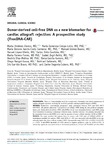Donor-derived cell-free DNA as a new biomarker for cardiac allograft rejection: a prospective study (FreeDNA-CAR)

Ver/
Use este enlace para citar
http://hdl.handle.net/2183/41524
A non ser que se indique outra cousa, a licenza do ítem descríbese como Creative Commons Attribution-NonCommercial-NoDerivatives 4.0 International License (CC-BY-NC-ND 4.0)
Coleccións
- Investigación (FEP) [507]
Metadatos
Mostrar o rexistro completo do ítemTítulo
Donor-derived cell-free DNA as a new biomarker for cardiac allograft rejection: a prospective study (FreeDNA-CAR)Autor(es)
Data
2024-11-20Cita bibliográfica
Jiménez-Blanco M, Crespo-Leiro MG, García-Cosío Carmena MD, Gómez Bueno M, López-Vilella R, Ortiz-Bautista C, Farrero-Torres M, Zegrí-Reiriz I, Díaz-Molina B, García-Romero E, Rangel-Sousa D, Salterain N, Garrido Bravo I, Segovia-Cubero J. Donor-derived cell-free DNA as a new biomarker for cardiac allograft rejection: a prospective study (FreeDNA-CAR). J Heart Lung Transplant. 2025 Apr;44(4):560-569.
Resumo
[Abstract] Background: There is a long-standing need for a noninvasive biomarker that allows monitoring of cardiac allograft rejection, avoiding the need for periodic endomyocardial biopsies (EMB).
Methods: Multicenter, observational, prospective study, performed between 2019 and 2023 (NCT04973943). All patients underwent 7 per-protocol surveillance EMB during the first postheart transplantation year. Donor-derived cell-free DNA (dd-cfDNA) levels were determined before each EMB, using Next Generation Sequencing Technology (Allonext assay, Eurofins Genome). The primary end-point was the association between dd-cfDNA levels and the presence of acute cellular rejection (ACR) in EMB.
Results: The study included 206 patients from 12 centers, with 1,090 pairs of EMB/dd-cfDNA determinations available for analysis. EMB with ACR (n = 49) were associated with dd-cfDNA levels significantly higher than those without, median 0.189% (interquartilic range 0.05-0.70) vs 0.095% (0.04-0.23), p = 0.013. A dd-cfDNA threshold of 0.10% showed a negative predictive value for ACR of 97%. A statistically significant association between N-terminal prohormone of brain (NTProBNP) and dd-cfDNA was also found, with an increase of 0.007% dd-cfDNA (95% confidence interval 0.003-0.011) for every 500 units of NTproBNP, p 0.001. The combination of both biomarkers for diagnosis of ACR showed an area under the receiver operating characteristic (ROC) curve of 0.681, and this combined approach was significantly better than dd-cfDNA alone (area under the ROC curve 0.603), p = 0.016. Using a cut-off point of 0.10% for dd-cfDNA and 1,000 UI/ml for NTproBNP, negative predictive value increased to 98.1%.
Conclusions: dd-cfDNA may be a useful biomarker to rule out significant ACR in a low-risk population. However, a dd-cfDNA value above normal threshold does not correlate robustly with the presence of disease. The combination with NTproBNP, a readily available biomarker, increased the discrimination power of dd-cfDNA alone.
Palabras chave
NTproBNP
Acute cardiac rejection
Biomarkers
Donor-derived cell-free DNA
Heart transplantation
Acute cardiac rejection
Biomarkers
Donor-derived cell-free DNA
Heart transplantation
Descrición
Observational study
Versión do editor
Dereitos
Creative Commons Attribution-NonCommercial-NoDerivatives 4.0 International License (CC-BY-NC-ND 4.0)
ISSN
1053-2498






